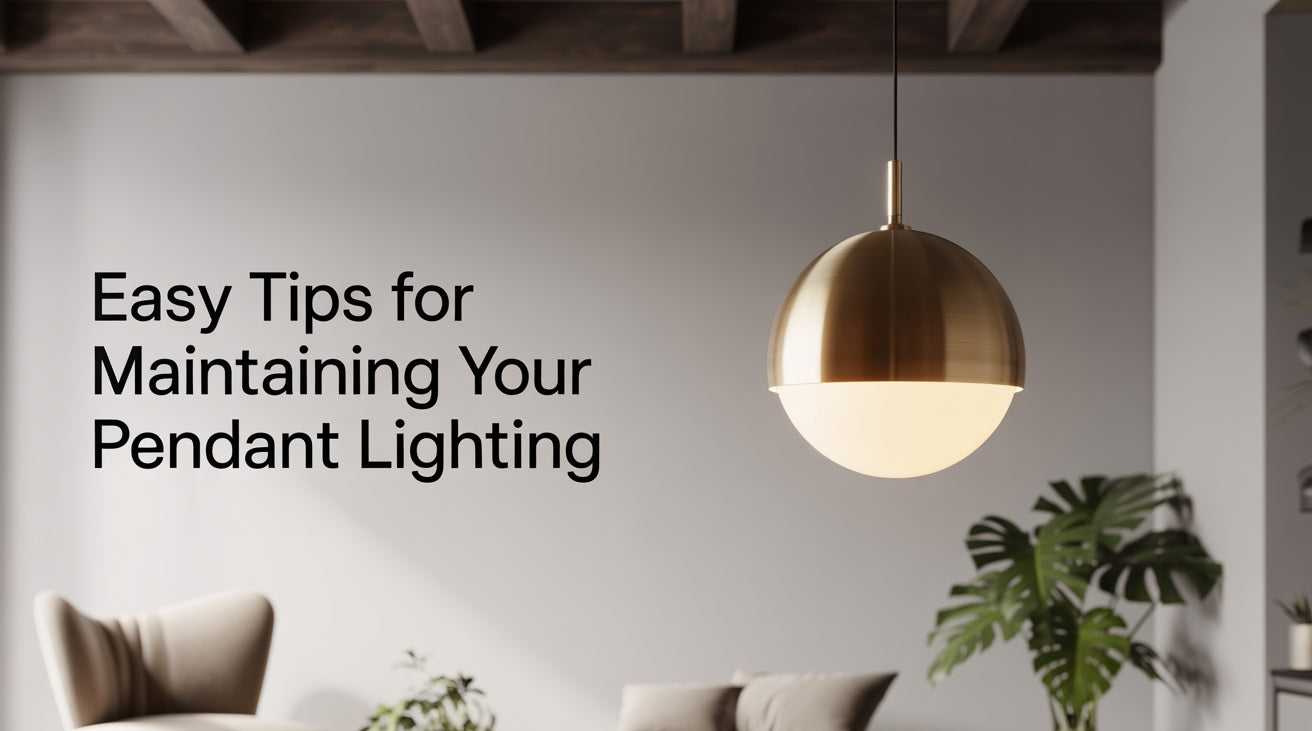Installing a modern chandelier can transform a room's lighting and look. But it's important to be safe during installation. This guide will show you how to properly install a chandelier while following key safety steps. We'll cover everything you need to know to successfully and safely hang your new chandelier.
Key Safety Tips for Chandelier Installation
- Turn off power at circuit breaker
- Use voltage tester to confirm power is off
- Ensure proper grounding
- Use correct wire gauge (18 AWG minimum)
- Verify ceiling can support chandelier weight
- Follow manufacturer's instructions
- Consult professional electrician if unsure
- Support chandelier with chain, not electrical wires
- Use GFCI protection in wet areas
- Ensure electrical connections meet local codes
Pre-Installation Considerations
Before you start installing, it's important to carefully think about your space and pick the right chandelier. Choosing the correct chandelier size is key for making the room look good and having enough light. A chandelier that's too big can make a room feel cramped, while one that's too small might not give enough light or look right.
Think about these important things:
- Room size: Measure how long, wide, and tall the room is to figure out the right chandelier size. A good rule is to add the room's length and width in feet, then use that number in inches for the chandelier's width.
- Ceiling height: This helps decide how low the chandelier should hang. For normal 8-foot ceilings, make sure there's at least 7 feet of space under the chandelier. For taller ceilings, you can hang it lower to make it stand out more.
- Current electrical setup: Check if your existing wiring and electrical box can handle the new chandelier. Older homes might need updates to meet safety rules.
- Chandelier weight: Make sure your ceiling and electrical box can hold the chandelier's weight. Heavy chandeliers might need extra support.
- Style: While not about safety, pick a chandelier that matches your room's style for the best look.
Safety First: Electrical Precautions
Being safe with electricity is super important when hanging a chandelier. If you're not careful, you could get hurt or start a fire. Follow these steps carefully:
- Turn off the power: Go to your home's main electrical box and turn off the power to the room where you're installing the chandelier. Don't just turn off the light switch - that's not enough to be safe.
- Check that the power is really off: Use a special tool called a voltage tester to make sure there's no electricity flowing through any of the wires in the electrical box.
- Ground the chandelier properly: Find the ground wire (it's usually green or bare copper) and connect it to the right spot in the electrical box. This helps prevent shocks.
- Know basic wiring: Learn what the different colored wires mean (black is hot, white is neutral, green or bare is ground) and how to connect them safely using wire nuts.
- Wear safety gear: Put on insulated gloves and safety glasses to protect yourself from possible electrical dangers and falling bits while you work.
Remember, if you're not sure about working with electricity or haven't done it before, it's best to hire an electrician. Paying for professional help is worth it to keep your home and family safe.
Tools and Materials Needed
Getting all your tools and materials ready before you start will make the job go smoother. Here's what you'll need:
- Voltage tester: To check if wires are live
- Screwdrivers: Both flathead and Phillips head in different sizes
- Wire strippers: For removing wire insulation
- Pliers: Needle-nose pliers are great for working with wires
- Ladder: A sturdy ladder tall enough to reach your ceiling safely
- Safety glasses: To protect your eyes
- Gloves: Insulated gloves for electrical work and regular work gloves for handling the chandelier
- Wire nuts: To join wires together safely
- Electrical tape: For extra insulation on wire connections
- Mounting hardware: All the brackets, screws, and anchors that come with your chandelier
- Level: To make sure your chandelier hangs straight
- Measuring tape: For precise placement
- Drill and bits: You might need these for new mounting hardware
- Circuit tester: To double-check your wiring before finishing up
- Fish tape: Helpful if you need to run new wires through walls or ceilings
Step-by-Step Installation Guide
1. Remove Existing Fixture
If there's already a light fixture where you want to put your chandelier, you'll need to take it down first. Here's how:
- Take off any shades, bulbs, or decorative parts from the old light
- Unscrew the canopy (the part that covers the wires) to see how it's connected
- Carefully disconnect the wires, remembering how they were connected
- Remove any screws holding the old fixture in place
- Gently lower the old fixture and set it aside
2. Install Mounting Bracket
Now you'll put up the new bracket that will hold your chandelier. Follow these steps:
- Check that the electrical box in your ceiling is strong enough to hold your chandelier
- If needed, put in a new electrical box that can support the chandelier's weight
- Attach the mounting bracket to the electrical box with the screws provided
- Use a level to make sure the bracket is straight before tightening the screws all the way
3. Connect the Wires
Connecting the wires safely is really important. Here's how to do it:
- Strip about 3/4 inch of insulation off each wire end
- Match the wire colors (black to black for hot, white to white for neutral, green or bare copper for ground)
- Twist matching wire ends together clockwise
- Put a wire nut on each connection and twist it on tightly
- Wrap electrical tape around each wire nut for extra safety
- Gently pull on each wire to make sure the connections are secure
4. Secure the Chandelier
Now it's time to hang the chandelier. This part is easier with a friend to help:
- Have someone hold the chandelier while you connect the wires if you haven't already
- Line up the chandelier's canopy with the mounting bracket
- Secure the canopy to the bracket with the screws or decorative nuts provided
- Use a level to check that the chandelier is hanging straight and adjust if needed
5. Install Light Bulbs
Finally, put in the light bulbs. Keep these things in mind:
- Use the right type and wattage of bulbs for your chandelier
- Think about using LED bulbs to save energy and last longer
- If your chandelier has a dimmer, make sure to use dimmable bulbs
- Be careful not to touch the glass part of the bulbs with your bare hands, as this can make them burn out faster
Our Misty Linear Kitchen Chandelier is great for modern kitchens. It looks cool and is easy to install. It's long shape gives even light over kitchen islands or dining tables, making it both useful and stylish.
Special Considerations for Different Chandelier Types
Crystal Chandeliers
Crystal chandeliers need extra care when you're putting them up:
- Unpack the crystal parts carefully and lay them out on a soft, clean surface
- Follow the instructions exactly for attaching the crystal pieces
- Consider wearing soft gloves to keep fingerprints off the crystals
- Put up the main part of the chandelier first, then add the crystal pieces after
- Be ready to spend more time on this type of chandelier because of all the small parts
LED Integrated Chandeliers
For chandeliers with built-in LED lights, make sure your electrical system can handle it:
- Check that your home's voltage matches what the LED chandelier needs (usually 120V in the US)
- If the chandelier needs a special power box, make sure it's installed correctly and hidden
- For chandeliers that change color or connect to smart home systems, learn how to set up the controls
- Think about get professional help to install complex LED systems to make sure they work right and last long
Extra-Large Chandeliers
Big chandeliers often need extra support to be safe and stable:
- Ask a professional to check if your ceiling is strong enough to hold the chandelier
- Put in a support beam between ceiling joists to spread out the chandelier's weight
- Use a heavy-duty electrical box that's made for heavy lights or ceiling fans
- Think about using a motorized lift system for easy cleaning and changing bulbs in high ceilings
- Make sure all the mounting hardware is strong enough for your chandelier's weight
Our Prue Extra Large Crystal Chandelier is perfect for big rooms but needs careful installation because it's big and has lots of parts. This beautiful chandelier mixes crystal elegance with a modern shape, making it great for big entry halls, hotel lobbies, or large living rooms.
Structural Support and Weight Considerations
Making sure your ceiling can hold the chandelier is super important for safety, especially for big or heavy ones. Follow these guidelines:
- Check that your ceiling beam can hold the chandelier's weight: Use a stud finder to locate beams and see how strong they are. For chandeliers over 50 pounds, ask a professional for help.
- Use the right mounting brackets and supports: Choose brackets that can hold at least 1.5 times the chandelier's weight to be extra safe.
- For chandeliers over 100 pounds, add extra wood support in the attic: This means putting a support beam between joists right above where the chandelier will hang.
- Think about using a special mounting system: For really heavy chandeliers, you might need a bar or plate that spreads the weight across several beams.
- Remember that the chandelier might weigh more when it's being cleaned or if it swings: Plan for this extra weight when setting up your support system.
Wiring and Electrical Connections
Getting the wiring right is crucial for safety and making sure your chandelier works well. Follow these guidelines:
- Use the right size wire (usually 18 AWG for chandeliers): Make sure the wire is thick enough to handle the electricity the chandelier needs. For bigger chandeliers or longer wires, you might need 14 or 12 AWG wire.
- Make sure all connections are tight and well-insulated: Use the right size wire nuts and wrap connections with electrical tape for extra safety.
- Leave some extra wire: Leave about 6 inches of extra wire to make connections easier and reduce stress on the wires.
- Use a junction box if needed: For chandeliers with many lights, a junction box can help organize and secure multiple wire connections.
- Think about adding a dimmer switch: Install a dimmer that works with your chandelier to change the mood and save energy.
- Label your wires: If your chandelier has complicated wiring, label the wires clearly to make future fixes or changes easier.
Chandelier Placement and Adjustments
Where you put your chandelier can really change how it looks and works. Think about these things:
- In dining rooms, hang the chandelier 30-34 inches above the table: This gives good light without blocking views across the table. For higher ceilings, you can hang it a bit higher.
- In living rooms and bedrooms, keep at least 7 feet between the floor and the chandelier: This makes sure people won't bump their heads and keeps the chandelier safe.
- Adjust the chain or cable to get the right hanging height: Most chandeliers come with adjustable chains or cables. Measure carefully and adjust before you finish the installation.
- Center the chandelier properly: In dining rooms, center it over the table. In living rooms, you might center it over a seating area instead of the middle of the room.
- Think about how it looks from different spots: Make sure the chandelier doesn't block important views or features when you look at it from key places in the room.
- For sloped ceilings, use a special mounting kit: This helps make sure the chandelier hangs straight even if your ceiling is angled.
The Nordi Rectangle Dining Room Chandelier is great for dining areas and comes in gold and black to match different styles. Its long shape is perfect for long dining tables, giving even light across the whole table. You can adjust its height to fit any ceiling or table size.
Post-Installation Safety Checks and Maintenance
After you install the chandelier, do these safety checks:
- Make sure all connections are tight: Gently pull on wires and check that all mounting hardware is secure.
- Test the chandelier: Turn on the power and test all the lights, including the dimmer if you have one.
- Check for any signs of overheating or electrical problems: After the chandelier has been on for about 30 minutes, carefully touch the canopy and wires to make sure they're not too hot.
- Check that it's hanging level: Use a level to make sure the chandelier is perfectly straight and adjust if needed.
- Check the chain or cable: Make sure supporting chains or cables aren't twisted or stressed.
Tips for keeping your chandelier safe and working well over time:
- Dust the chandelier often: Use a soft, dry cloth or duster to keep dust off, which can affect the light and be a fire risk.
- Check and tighten loose parts: Regularly check all visible screws, nuts, and decorative parts to make sure they're tight.
- Replace bulbs when needed: Use the right type and wattage of bulbs as the manufacturer says.
- Clean crystals or glass parts: For crystal chandeliers, carefully clean each piece with a cleaner the manufacturer recommends.
- Check wiring once a year: Look for any signs of wear, fraying, or discoloration in visible wires.
- Have a professional check it: Consider having an electrician inspect your chandelier every few years, especially for complex or old fixtures.
When to Call a Professional
While many people can install a chandelier themselves, sometimes it's best to get professional help. Think about hiring an electrician in these situations:
- If the electrical work is too complicated for you: If you're not sure about any part of the wiring or electrical connections, it's best to ask a professional.
- For chandeliers weighing over 100 pounds: Heavy chandeliers often need special mounting techniques and might require changes to your ceiling structure.
- If you have old or unusual wiring: Older homes might have aluminum wiring or other old systems that need expert handling.
- If local building rules require it: Some places require licensed electricians for certain types of lighting installations.
- For very high ceilings: If your chandelier will hang from a very high ceiling, professional installers will have the right equipment and experience to work safely at heights.
- For smart or complex LED systems: Chandeliers with advanced lighting controls or smart home features might need professional setup to work correctly.
- If you need to make changes to your ceiling: If your ceiling needs reinforcement or if you need to move an electrical box, these jobs are best left to professionals.
Conclusion
Installing a modern chandelier can really improve your home's lighting and style, changing the feel of any room. By carefully following these safety guidelines and installation steps, you can make sure your installation looks great and is safe and functional. Remember, the key to successfully installing a chandelier is careful planning, paying attention to details, and always putting safety first.
While many homeowners can install a chandelier themselves, it's important to honestly think about your skills and comfort with electrical work. If you're not sure, it's always best to ask or hire a professional electrician. Paying for professional installation is worth it to keep your new light fixture safe and working well for a long time.

















